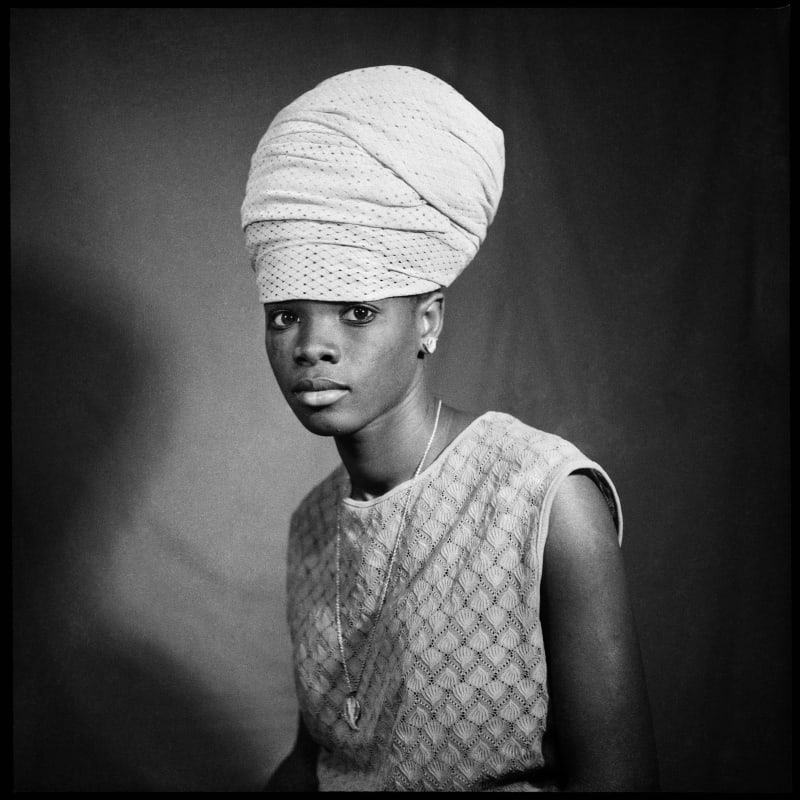It was music that first drew the French journalist and music producer Florent Mazzoleni to Burkina Faso in west Africa. The town of Bobo-Dioulasso, the country’s second largest city and its cultural capital, had been a sonic hothouse in the 1960s and 1970s: the birthplace of the Volta Jazz Orchestra, the military band Les Imbattables Léopards, and Dafra Star, known for its exuberant rhumba, jazz and Cuban rhythms.
Mazzoleni loved how the record covers of the period captured the fun, sweat and skill of Bobo-Dioulasso’s musicians and set out to find the photographer, Sanlé Sory. He tracked him down to outside his studio “Volta Photo”, tossing photos and negatives onto a bonfire. “These are old things,” said the elderly man, dismissively.
Mazzoleni ended up trawling through Sory’s archives, which contain more than 200,000 negatives and stretch back to 1960, the year that the small land-locked country of Upper Volta, as Burkina Faso used to be called, was granted independence from France. Sory opened a tiny studio to meet the increasing public demand for headshots for identification papers. The French may have left but colonial-style bureaucracy remained. Located on a dusty, dirt road, it was nothing fancy, Sory remembers: “People crapped behind my studio.”
Sory was supported in his venture by his cousin Idrissa Koné who needed someone to photograph album covers for Volta Jazz, the band he was managing. He produced a dozen images of the band in a day using a single 12-exposure roll of colour film. He got them to pose in front of the bandstand, theatre, zoo, gardens and even the local driving school which was also owned by his cousin. The photographs would be printed in Abidjan, Ivory Coast, and the record sleeves made in Italy.
During the day, Sory worked on headshots and larger portraits. At night he attended dance parties. In the 1970s he even started organising his own events, compiling mixtapes, driving to the villages surrounding Bobo with an amp, tape deck, speakers, lights, cameras and a diesel-powered generator, and charging guests an entrance fee. If they bought a photo, so much the better. In a recording by Dafra Star, frontman Coulibaly Tidiani announces: “If it is true that Africa belongs to Africans, it is true that Upper Volta belongs to the Voltaic people in general, and young people in particular.” This sentiment reflects the spirit of Sory’s photographs.
This year, after a show at the 1:54 Contemporary Art Fair in Marrakech in February, the Yossi Milo Gallery will exhibit over 90 portraits in New York and publish a limited-edition book. The Art Institute of Chicago (AIC) is showing a greater range of his pictures, alongside a catalogue by Steidl. The success of Malick Sidibé, a Malian photographer and contemporary of Sory’s, has undoubtedly buoyed interest in 20th-century west-African photography. It gives historical context to what many of the region’s most successful artists are doing today. It is also a less costly and more accessible way for museums, particularly regional ones, to boost their collections of African art. In the past year, Sory’s photographs have been acquired for the permanent collections of museums including the Minneapolis Institute of Art and the North Carolina Museum of Art. At a time when much media coverage of Africa is tinged with hopelessness, they take us back to a more optimistic era.
The confident poses and carefully chosen accessories of Sory’s subjects resemble the portraits of the Malian photographer Malick Sidibé. Sory appears not to have been directly influenced by Sidibé – the similarity is simply down to the cultural forces and new technology sweeping West Africa at the time.
Sory’s photographs are perhaps a little more rough and ready than Sidibé’s: in this photograph, the lights clip the frame because there simply isn’t enough room in “Volta Photo”, Sory’s studio. How better to signal your musical preferences than by holding up a record sleeve? This young man, sitting in Inter Music, one of the many record stores in Bobo in the mid-1970s, has selected a single by Johnny Hallyday,
the French singer, with lyrics that imagine Jesus Christ as a hippy, visiting Woodstock and smoking weed. It was definitely a record of its time.
This photo shares its name with the Luis Buñuel film released eight years earlier. Unlike Catherine Deneuve who, in the poster to promote the film, stares enigmatically into the distance, here the sitter looks straight into the camera. It’s amazing how closely a young woman from Upper Volta in the 1970s can resemble Vermeer’s “Girl with a Pearl Earring”.
The respect Sanlé has for his instrument is clear: it takes centre frame. This picture gives us an insight into his cheeky personality and his enthusiasm for bodybuilding. You can just make out the scarification on his cheeks, a tribal marking to signal rank and ethnicity. The contemporary Ivorian photographer Joana Choumali is known for her portraits of this disappearing tradition.
Travel has always been an aspiration for young Africans, and photography was a way to play out this fantasy. The aeroplane taking off is a popular backdrop in Sory’s photography, with some sitters even donning pilot gear and Air Afrique shoulder bags. Gallery owner Yossi Milo found the original double-sided backdrop used here. On the other side? A beach.

